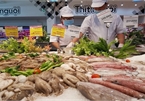on combating illegal, unreported and unregulated (IUU) fishing for the purpose of having the "yellow card" removed.
 |
The first half of the year has seen seafood export value stand at an estimated US$3.56 billion, equal to 91.4% compared to the same period last year and fulfilling 35.6% of the set target.
The Vietnam Directorate of Fisheries under the Ministry of Agriculture and Rural Development anticipates that seafood resources will decline in terms of both quantity and quality during the second half of the year as a result of unpredictable developments caused by the novel coronavirus (COVID-19) epidemic. In addition, continued drought and saltwater intrusion will continue to affect aquaculture in several areas.
Moreover, the security situation at sea remains tricky with no clear pathway to resolution as regional nations move to intensify their control of fishing activities at sea whilst traditional fishing grounds are becoming increasingly narrow.
Despite these negatives, the industry is striving to complete all set targets for this year, with total aquatic output and export turnover aiming to reach 8,565.6 million tonnes with a respective value of US$10 billion.
Nguyen Hoai Nam, deputy general secretary of the Vietnam Association of Seafood Exporters and Producers, said the opening six months of the year have seen seafood exports fall by more than 8% compared to the same period last year.
This indicates that reaching the export target of US$10 billion for the year represents a huge task and will take a great deal of effort, especially in terms of boosting exports to China.
"After the epidemic in Vietnam was brought under stricter control over the past two months, China increased its import of Vietnamese seafood. However, in the last two weeks when China detected the COVID-19 in three Ecuadorian shrimp bags, the northern neighbour’s tightened import has affected Vietnamese seafood exports to the major market. Meanwhile, other large markets of Vietnamese seafood are encountering hurdles due to the impact of the COVID-19," Nam said.
Efforts for yellow card removal
According to Phan Thi Hue, head of the Legal Inspection Department under the Vietnam Directorate of Fisheries, the Directorate of Fisheries is studying relevant documents which can be sent to coastal localities in an effort to clarify overlapping waters and make a list of all ships notified of violations by foreign countries or Vietnamese functional forces.
This step is being carried out alongside receiving direct guidance in order to form the basis for the country to work more effectively with the EC, she notes.
Ha Le, deputy director of the Fisheries Control Department says, “In recent times, violations in foreign waters by fishermen, especially in the overlapping waters of Malaysia, have been very complicated. A meeting of the National Steering Committee on IUU is set to be held in late July, during which the Department will come up with solutions to prevent Vietnamese fishing vessels' violations in overseas waters.”
In the face of a number of shortcomings and problems in removing "yellow cards", Deputy Minister Phung Duc Tien has requested the Directorate of Fisheries strengthen its direction, guidance, and inspection activities to urge localities to carry out the task of combating IUU fishing.
This must be done whilst ramping up communication about law dissemination for fishermen as a way of raising awareness of necessary law observance and the process of fighting against IUU fishing. He has also outlined the necessity of preparing plans for future meetings with the EC Delegation to Vietnam.
VOV

Yellow card causes big losses to Vietnam’s seafood exports to EU
The average loss for each container of shipments to the EU due to the EC’s yellow card is 10,000 euros, according to a source.

EC's yellow card could see local seafood exports to EU taking a hit
Vietnam’s seafood shipments to the European Union (EU) may encounter losses of up to 10,000 euros (US$11,125) per container due to the impact of the European Commission’s (EC) yellow card on local seafood products,